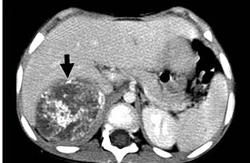
July 5, 2011 – A new treatment option may soon be available for children with neuroblastoma, according to research published in the July issue of The Journal of Nuclear Medicine. The study tested the principle that combined positron emission tomography and X-ray computed tomography (PET/CT) may be used to select children with primary refractory or relapsed high-risk neuroblastoma for treatment with a molecular radiotherapy known as 177Lu-DOTATATE. This therapeutic option was found to be a viable option for children with neuroblastomas. Neuroblastoma is a cancerous tumor that develops from nerve tissue in infants and children. Accounting for six to 10 percent of all childhood cancers, it does not always follow the same pattern, with some patients regressing spontaneously and other progressing, despite aggressive therapy. The long-term survival rate for neuroblastoma is below 40 percent. "We know that peptide receptor radionuclide therapy in adults with somatostatin-positive neuroendocrine tumors has resulted in improved symptoms, prolonged survival and an enhanced quality of life. Since some neuroblastomas express somatostatin receptors, we felt this approach could be beneficial to children as well," said Jamshed B. Bomanji, MBBS, PhD, FRCR, FRCP, one of the authors of the study "177Lu-DOTATATE Molecular Radiotherapy for Childhood Neuroblastoma." In the study, eight children with relapsed or primary refractory neuroblastoma were imaged with a 68Ga-DOTATATE PET/CT scan. If the disease sites showed 68Ga-DOTATATE uptake greater than the liver, the child was considered eligible for the molecular radiotherapy. Therapy with 177Lu-DOTATATE was determined to be suitable for six of the children and was administered appropriately. After completing treatment with 177Lu-DOTATATE, five children had stable disease by the response evaluation criteria in solid tumors. The treatment was feasible, practical and well-tolerated in the small group of patients with high-risk neuroblastoma. As a result, the researchers plan to evaluate 177Lu-DOTATATE formally in a phase I-II clinical trial to evaluate toxicity and response. "Molecular imaging has contributed a new diagnostic technique to map the full extent of disease. This mode of treatment has great potential for children whose treatment options are limited, as neuroblastoma often becomes resistant to chemotherapy and success is limited by poor bone marrow reserve," said Bomanji. For more information: www.snm.org


 April 17, 2024
April 17, 2024 








